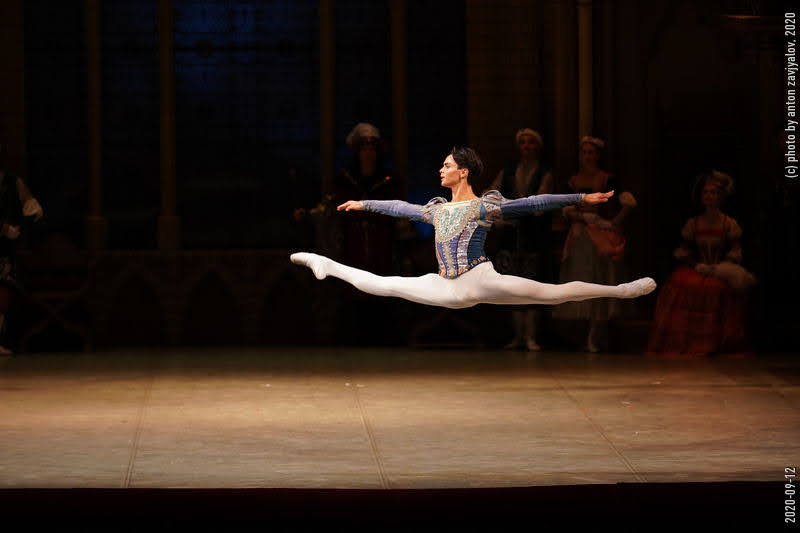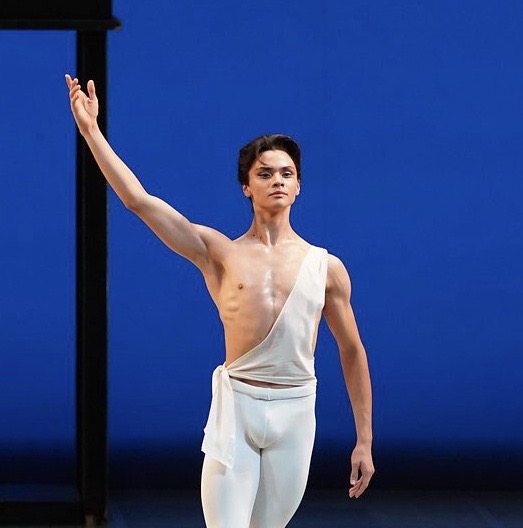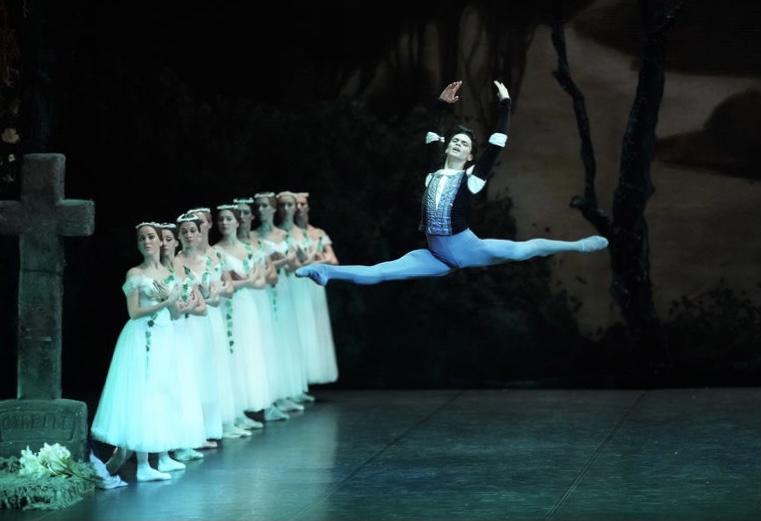Yago Gonzaga received his early ballet training in Brazil, performed with the Perm Ballet Theatre in Russia, and after being spotted by Laurent Hilaire, more recently became a soloist in Munich’s Bayerishe Staatsballett. His incredible lines, elastic flexibility and innate musicality mixed with a deep sense of romanticism make him not just a talented dancer, but one who clearly will become a principal with the troupe before long. VaganovaToday spoke with him about his career path to date.
Why did you start ballet, what drew you to it?
It was actually by accident because I performed folkloric Amazonian dances as a child since I am from the Amazon part of Brazil. This type of dancing doesn’t require flexibility or gymnastics, it’s very simple, walking circles, for example. My first introduction to ballet was after joining the Bolshoi School, which was heavily influenced by Vladimir Vasiliev and Alexander Bogatirev. They had created their own ballet school in Brazil based on the Bolshoi style and Moscow curriculum. They held auditions for small kids who wanted to join and searched for those who had talent, offering scholarships to the school. At that time, I had never heard of the Bolshoi. But I wanted to get out of class, so I said I was interested. I went to the audition and they said I had potential. This was in November or December, I was 13 years old at the time. I began studying at the school that January.
What were your impressions of the Bolshoi Theatre School [“Escola do Teatro Bolshoi”] in Brazil?
The school has piano lessons, history of dance/music, historical popular dance, character, ballet, and duet classes — all the same subjects as the Moscow Choreographic School offers. We attended for 6 hours a day, and you had to do both the academic side and the physical, dancing side of the curriculum. You have to be very good in academics to keep your scholarship. For the first 4 years of 8 years in school we had ballet classes in the mornings and academics in the evening. During the last 4 years it was the opposite: academics in the morning, and ballet in evening. Then after 6 p.m. we would have rehearsals for repertoire and shows.
When I joined the school, it was the first time I had seen something so impressive: the ballet studios were beautiful! The rooms we had were big and I was very small. I remember running in Studio 4, it’s one of the biggest. I thought, ”Wow this is so big, how can I dance here?”At that time I thought you needed very long legs to dance in a space that big!
What were the teachers like?
I attended during a period when Brazil could still allow teachers to be very strict without being politically correct. It was very regimented. We could never run in the corridor, we could not walk in our ballet shoes in the halls, we had to greet others in the hallway. It was strict but I feel it was also good timing, I think it was good for my education.

(Gonzaga pictured above in Swan Lake)
Were the classes difficult?
In terms of ballet technique – it was not that it was easy or hard… God blessed me with a body [with good turnout and feet] that can easily do all of the positions, battement tendu, and so forth — those were not a challenge for me. However, I was intrigued when the teachers explained how to do it, how to use this muscle and push here or there. This is what made it hard, but it actually made me more interested. As I studied, I found that I could do it, and do it better, I was excited about that.
When did you know you wanted to be a professional ballet dancer?
At 13, at the end of the first year or even after just 3 months in the school, I knew I wanted to be a professional. When I was little, I always wanted to be a pilot. But I started ballet and enjoyed it. So when I attended the school at first, I was not thinking,”is this a career or what I want to do for the rest of my life,” until I started seeing videos from Bolshoi and Mariinsky. The very first video I watched was at my house, it was Yulia Makhalina and Igor Zelensky in Swan Lake. I remember the ballerinas and the jumping and turning, and I thought, “Wow, I really want to do that, I want to dance that role.” From that moment on, I completely forgot about anything else. It wasn’t something I clearly knew at the time, but I would say looking back that that was when I wanted to be a professional.
 Who are your male role models, in terms of ballet dancers?
Who are your male role models, in terms of ballet dancers?
Zelensky was my idol for that particular video, but my first one was Vladimir Vasiliev because I used to watch him in the school. We had a TV on all the time that continuously showed him dancing in The Nutcracker, Spartacus, and The Elegie, the dramatic adagio his choreography with Ekaterina Maximova.
Vasiliev was at the school with us at least once a year to watch our exams. I danced the Prince when he came to watch The Nutcracker. He personally rehearsed The Elegie and Don Quixote with me while I was still a student.
What happened when you graduated?
There is a junior company associated with the school in Brazil that is meant for us to obtain stage experience for a year after graduation more or less. Then you pursue auditions. For me this was not so easy, Brazil is very far from Europe and I didn’t have the money. The year I graduated I continued to train and earn money at the same time, so I could visit Europe and Russia. Actually, my dream was always to dance in Russia. Then, when I was in the junior company, Vasiliev came and rehearsed the entire Nutcracker with us. He told our ballet director that my partner and I should attend the Arabesque competition in Perm (the annual competition named after Vasiliev’s wife, Ekaterina Maximova).
I worked to save money, then flew to Perm to the Arabesque competition with my partner. That’s where I met Alexei Miroschnichenko. He spoke to us after the third round, asking if we wanted to join his company. He said Perm would be glad to have us. I was so surprised to get a job in a Russian theatre. It was one of my happiest moments.
So I flew back to Brazil, got my belongings and a visa. It actually took about 5 months to get the documents ready.
(Photo above, Gonzaga in Giselle as Albrecht, Perm State Theatre)
What was the move to Perm like? Did you have culture shock?
When I arrived, it was summer and I was struck by the weather: the long days. That was my first impression, as I was jet-lagged and could not sleep. I looked at my watch and recall seeing it was 1 o’clock in the morning but still daylight. That was the best experience I had. Later when the snow started coming, I wasn’t shocked, I was happy. It was my first contact ever with snow, so I was in awe. I was like, “WOW snow.” Everybody was looking at me, thinking “this guy is crazy.” (laughs)
How were the pedagogues in Perm compared to your experience with teachers in the Bolshoi school in Brazil?
This is tricky because both are Russian, but our school was Bolshoi style and Perm is Mariinsky style, it’s Vaganova, it’s very academic. When I came to Perm and I had Vitaly Poleshuk as my coach. I am very blessed that God gave him to me in my career, but it was a big adjustment because there were lots of details to pick up. These details were very, very important and you had to do it that way because that’s how they wanted it. It’s the style of the theatre. What is more beautiful about Perm as a troupe is that they have a style, it is a good style and they preserve it in the most beautiful way possible. After all, ballet is about beauty and academicism.
 What was your first solo role in Perm?
What was your first solo role in Perm?
When I arrived I danced first Bluebird Pas de Deux as a soloist and then I danced Albrecht in Giselle. After that I knew I had been made a principal dancer. When I was hired, I was so young, I didn’t bother to ask what my contract level was, but I knew I would dance solo roles. And fortunately this changed very quickly to principal roles.
You worked with the famous choreographer Alexei Miroschnichenko during his tenure at the Perm Theatre, and he promoted you to principal dancer there. What was it like working with him? When I met him he was excited and proud of having hired several Brazilians.
I worked a great deal with Vitaly but I worked on the Jerome Robbins Spring pas de deux with Miroschnichenko. It was an amazing experience because he has such an eye for detail and a talent for seeing everything, especially what matches and suits you best. I rehearsed Giselle, Nutcracker, Spectre de la Rose and of course Swan Lake with him. That was his favorite, Swan Lake, you can hear it in his voice when he talks about it.
(Photo: Yago Gonzaga in the studio with the legendary Vladimir Vasiliev)
I understand you had plans to shift to another company before Covid even began. What incited you to leave Perm?
Actually when I heard that Laurent Hilaire was setting Nureyev’s version of Don Quixote in Moscow, I thought “Oh my God, I want to work there, he’s doing this in Russia!” I love Nureyev’s choreography, it was my dream to dance it. For me, this is everything I needed. I got so excited. So I contacted him and then auditioned for the Stanislavsky, but it was a turbulent time. I got injured and decided not to go because I could not manage it, I was already in Perm and had my repertoire there. I decided to wait out my recovery and stay.
How did it happen that you ended up not in Moscow but in Munich?
When the events in Ukraine started, the Embassy called and advised me to leave, so I left Russia and stayed in Vienna for 3 months, from where I could audition around Europe. After this time, I received an offer from Bayerisches Staatsballett to join their company. I had had other offers already so it was a hard decision to make, but I have always wanted to work with Laurent, so it felt like the perfect time.
What was it like to start dancing in Munich?
Honestly, I was a bit concerned at first, because the style and repertoire is very different from what I was used to. I was overwhelmed, that’s the word. But I was ready to take on the challenge, and from then I started to like it. So that’s the fun part, to be able to do it and succeed.
What do you like about Munich, about Germany?
I love the city, it’s beautiful and there is lots to do here. I like it very much.
Do you speak German in the troupe? What’s the main working language?
We speak English and Russian mostly. When I have solo rehearsals we have teachers who speak Russian and almost all of the pianists here are Russian, so I use my Russian all the time. In fact, we have only 1 German in the company.
But outside of the company, the biggest challenge is the language. Mostly people speak English but sometimes they don’t, so you have to know a little bit.
Tell us what you’ve danced so far.
Benvolio in Cranko’s Romeo and Juliet, the Autumn solo in Wheeldon’s Cinderella, the Gardeners in Neuemeier’s Midsummer Night’s Dream, and solos in Ratmansky’s Pictures at an Exhibition and in his new creation Tchaikovsky Overtures.
Do you have any dream roles here at Bayerisches Staatsballett?
Yes everything (laughs). Of course my dream role is Diamonds. But also Solor in La Bayadere, and the Prince in Wheeldon’s Cinderella.
Many people have commented working with Laurent Hilaire – can you comment on what it is like to work with him. Do you feel the Nureyev connection?
Surprisingly, despite his French basis, I feel a lot of Russian style in Hilaire’s taste. I remember when we were rehearsing the Autumn solo, he liked the Russian energy, much like “Don Quixote”. For certain steps he emphasized the staccato and strong ending, this to me is very Russian and familiar. He encouraged me to use my skills, he told me “this is the Russian style, you worked in Russia, so use it.” His French side is more evident when he wants accuracy in port de bras and footwork — I feel French technique is naturally faster and more compact. I love adding French quality to my dancing. It’s not easy yet, but it is my aspiration this year to get there. So yes, lots of Russian influence but I can see that he’s French. He loves passion, and he likes to see that passion in his dancers.
Laurent is a very nice person, very kind, and if you need something or have questions you can ask him. He also comes to you to ask if everything is ok, he always checks in, it’s nice.
(Photo: Gonzaga in Perm’s Chopiniana)
Do you get to see your relatives much? When is last time you saw them?
Well when I was in school, I began living alone at age 15. My mother and sister are still in Brazil, so I saw them when I returned to get my visa, but mostly we FaceTime or talk by phone.
Advice for young dancers?
I would say everyone should try ballet to see if you like it and if so, see if you love it, and if you love it just never give up! If you keep working and keep dreaming things happen, you just have to keep your passion on fire.
(Published February 2023)


